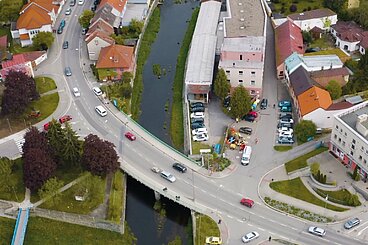The requirements for drinking water are high. To ensure its impeccable quality and protect consumer health, there are worldwide approvals and certifications for pipes and components used to transport drinking water. What is the difference? An approval is granted by a government agency. Certification is carried out by a recognised private institute. In declarations of conformity, the manufacturer certifies that its products comply with the regulations and refers to the test reports of an accredited laboratory. In most countries, such as Germany and the USA, these are hygiene certifications. For ease of understanding, the term "certification" will therefore be used in the rest of this text. In some countries, such as Germany, certification ensures that materials and products do not release harmful substances into the water in impermissible quantities, do not promote microbial growth and do not have any undesirable effect on the smell, taste or appearance of the water.
Safety through tested quality
Quality plays an important role in Rädlinger Primus Line’s products. This begins with the selection of raw materials for liners and connectors: only virgin materials from renowned manufacturers are used; recycled materials are not used. A seamlessly monitored manufacturing process ensures high product quality.
"We want to offer our customers a safe product. Drinking water is our most precious commodity. Thanks to our hygiene certifications, customers can rest assured that transport in our liners and connectors is safe. For us, safety goes beyond the manufacturing process itself," explains Andreas Gross, Head of the Business Unit – International Water Projects at Rädlinger Primus Line.
How does drinking water certification work?
At national level, a law regulates the requirements that water must meet in order to be classified as drinking water, as well as the specifications for materials and products that come into contact with drinking water. In some countries, there are additional implementation rules that contain precise test specifications for the hygiene certification of materials and products that come into contact with drinking water. If there are no such implementation rules, the law can be interpreted differently in certain respects. In any case, however, an accredited testing institute checks conformity with the legal requirements. This test can be carried out either through real product tests or through the recognition of equivalent, already existing certifications. Depending on country-specific regulations, a mixed form is also possible. The result is always a test report and, if applicable, a certificate or approval document. The applicant has no influence on the form of the document issued. The correct designations in the document can be difficult depending on the degree of language barrier and the specifications of the testing institute.

In Germany and the United States, the approval requirements are very high and the tests are very thorough. Manufacturers of products for global use have them certified in these countries at least. These certifications are always product-specific. In real product tests, the entire product is relevant, which is why these are carried out on the finished product or, in certain cases, such as complex product geometries, on simplified test specimens. In the case of simplified test specimens, however, it is absolutely necessary that they undergo the same or an equivalent manufacturing process so that they are as representative of the product as possible. For Primus Line® technology, both the liner and the connectors are subjected to real product tests. In some other countries, however, only the inner layer of the liner or the coating of the connectors is relevant, as only these materials come into direct contact with the drinking water. The requirements and testing effort are therefore lower overall.
In countries with high requirements, the first step in certification is always a formulation test. To this end, the manufacturer discloses the raw materials it uses to the testing laboratory. The testing laboratory traces the composition of the raw materials back to their original manufacturers and evaluates them in accordance with legal requirements. Depending on the type and scope – each certification has its own requirements and procedures – a formulation test can take up to two years. This is because all suppliers and sub-suppliers must also disclose their formulations.
The tests for migration, microbiology and other physiochemical tests, which the laboratory only carries out after the formulation has been checked, also take different lengths of time depending on the country and the specific characteristics. The test periods can range from 24 hours for a pure migration test to up to six months for a comprehensive test. In some cases, laboratories test for more than 200 ingredients in the area of migration. Some of these tests have to be outsourced to third-party laboratories, which takes additional time.
Obtaining hygiene certification can therefore take between four weeks – in this case, it is a pure recognition – and 18 months: a process that can be lengthy, time-consuming and costly. It starts all over again as soon as the composition of the product changes, for example when one raw material is replaced by another.
„Typical hygiene certifications for Primus Line® products take between four weeks and twelve months. We also offer the option of factory audits. This allows our customers to verify that we meet the standards and requirements.“
Andreas Gross, Head of Business Unit – International Water Projects | Rädlinger Primus Line
However, Rädlinger Primus Line goes even further than the basic requirements. The connectors are certified according to the North American standard NSF/ANSI/CAN 372 and are therefore considered lead-free. In addition, the liner has been tested for per- and polyfluorinated alkyl substances (PFAS) in accordance with NSF/ANSI/CAN 61. All values in these tests were not only below the maximum pollutant limit, but even below the detection limit. The Primus Liner can therefore be designated as PFAS-free. Testing for PFAS is currently still voluntary, but will become mandatory in the USA from 1 January 2028. This means that it already offers customers additional security for the coming years.
Certificates are generally valid for two to five years. Recertification is required at the latest by then.
Current drinking water certifications for Rädlinger Primus Line
Rädlinger Primus Line currently has 16 drinking water certificates worldwide. The most important of these are:
- USA: NSF/ANSI/CAN 61
- Hong Kong: BS 6920
- Germany: KTW-BWGL (evaluation basis for plastics and other organic materials in contact with drinking water)
Foreign certification bodies partially recognise certifications already issued by other certification bodies, and in some cases recognise them in full. For example, certifications according to British or North American standards are often recognised for local certification in the Asia-Pacific and South American regions.
At EU level, a harmonisation of certificates is planned from 1 January 2027. National certificates may still be used until the end of the transition period in December 2032, after which an EU certificate will be mandatory.
Conclusion
Certifications and tests are essential in all regions to meet the high requirements for drinking water quality and health protection. They form the basis for trustworthy water supply systems and minimise the risk of chemical or microbiological contamination.
With Rädlinger Primus Line, every customer can be 100% sure that the installed Primus Line® system is exactly the same as the one that has been tested and certified.
Checklist: How can I recognise a genuine hygiene certificate?
Not all certificates are perfect. Sometimes errors only become apparent afterwards, for example an incorrect validity period or an incorrect interpretation of the test criteria by the certifier. If you note the following points, it is highly likely that the certificate is genuine:
- Is the certificate consistent?
Product name, date, report/certificate number, test basis, accreditation of the laboratory/certifier - Does the certificate/report contain a number?
If in doubt, you can use this to ask the certifier whether the report is authentic and which products were tested. - What is the date of issue?
Be cautious if the date is very old (more than five years ago). - Is an expiry date specified for the certificate?
If so, this should match the date of issue and, of course, not be in the past.
As an operator or planner, you should be able to easily recognise whether the certificate is valid for your desired product. If in doubt, you should check directly with the issuer of the certificate. If you still have doubts, you should choose another product or request certification from another certifier.
Stay up to date with Primus Line: Subscribe to our newsletter now!
Information about sending newsletters with the provider CleverReach, evaluation, and your unsubscribe options can be found in our privacy policy.



